OpenTelemetry 深度定制:跨服务追踪的实战技巧
背景

在上一篇《从 Dapper 到 OpenTelemetry:分布式追踪的演进之旅》中在最后提到在做一些 Trace 的定制开发。
到现在差不多算是完成了,可以和大家分享一下。
我们的需求是这样的:
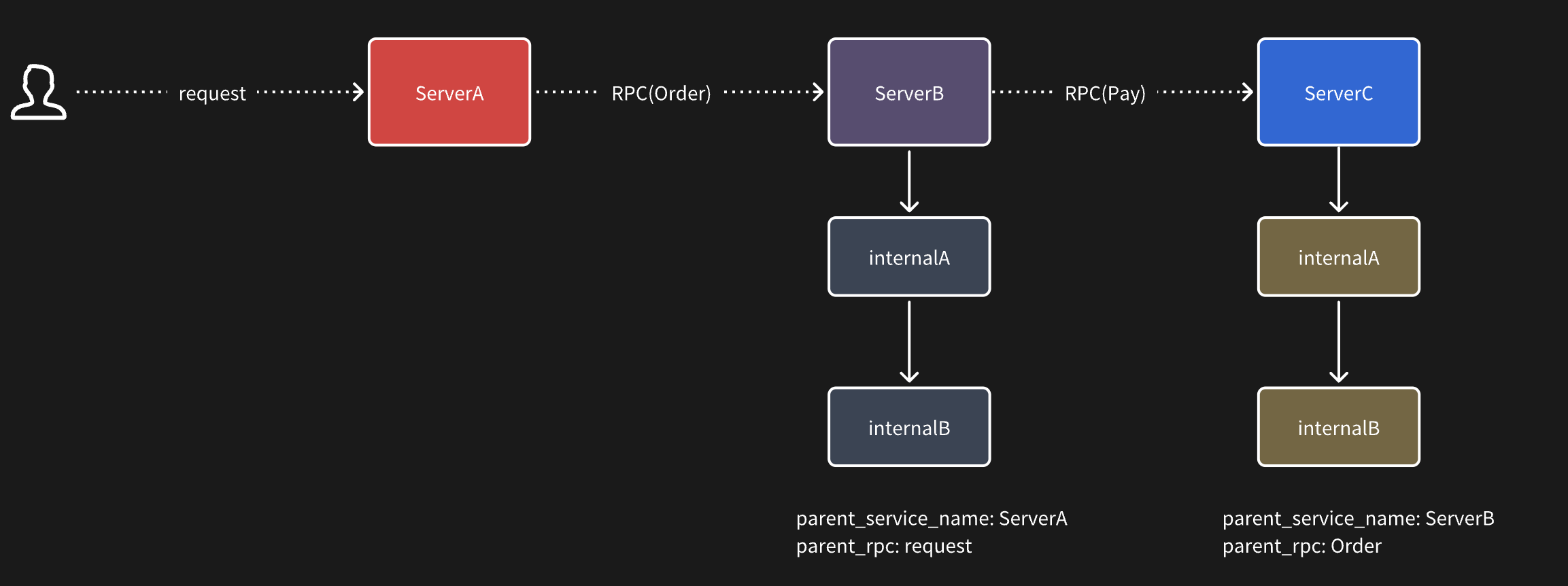
假设现在有三个服务:ServiceA、ServiceB、ServiceC
ServiceA 对外提供了一个 http 接口 request,在这个接口会调用 ServiceB 的 order 订单接口创建订单,同时 serviceB 调用 serviceC 的 pay 接口。
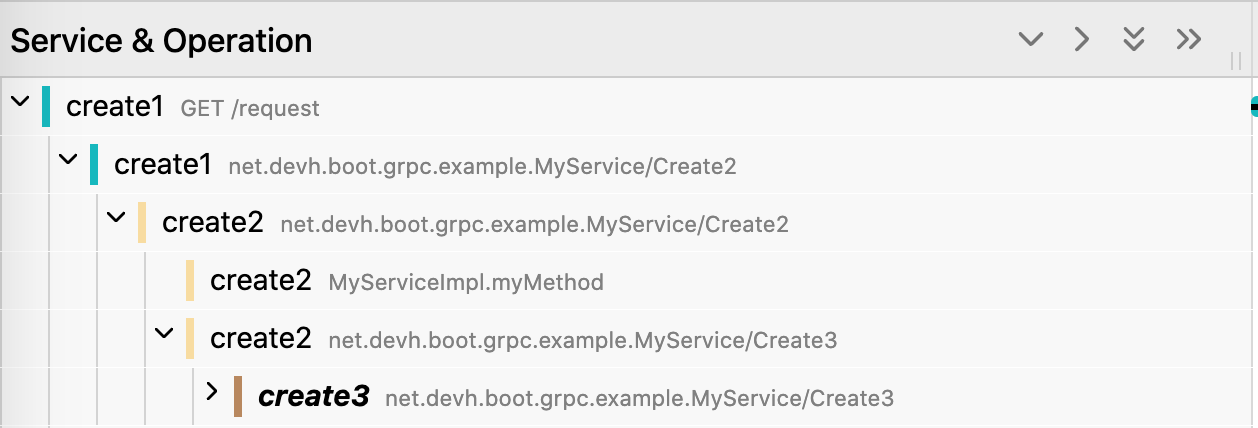
整个调用关系如上图所示。
默认情况下 span 中的 attribute 会记录当前 span 的一些信息,比如:
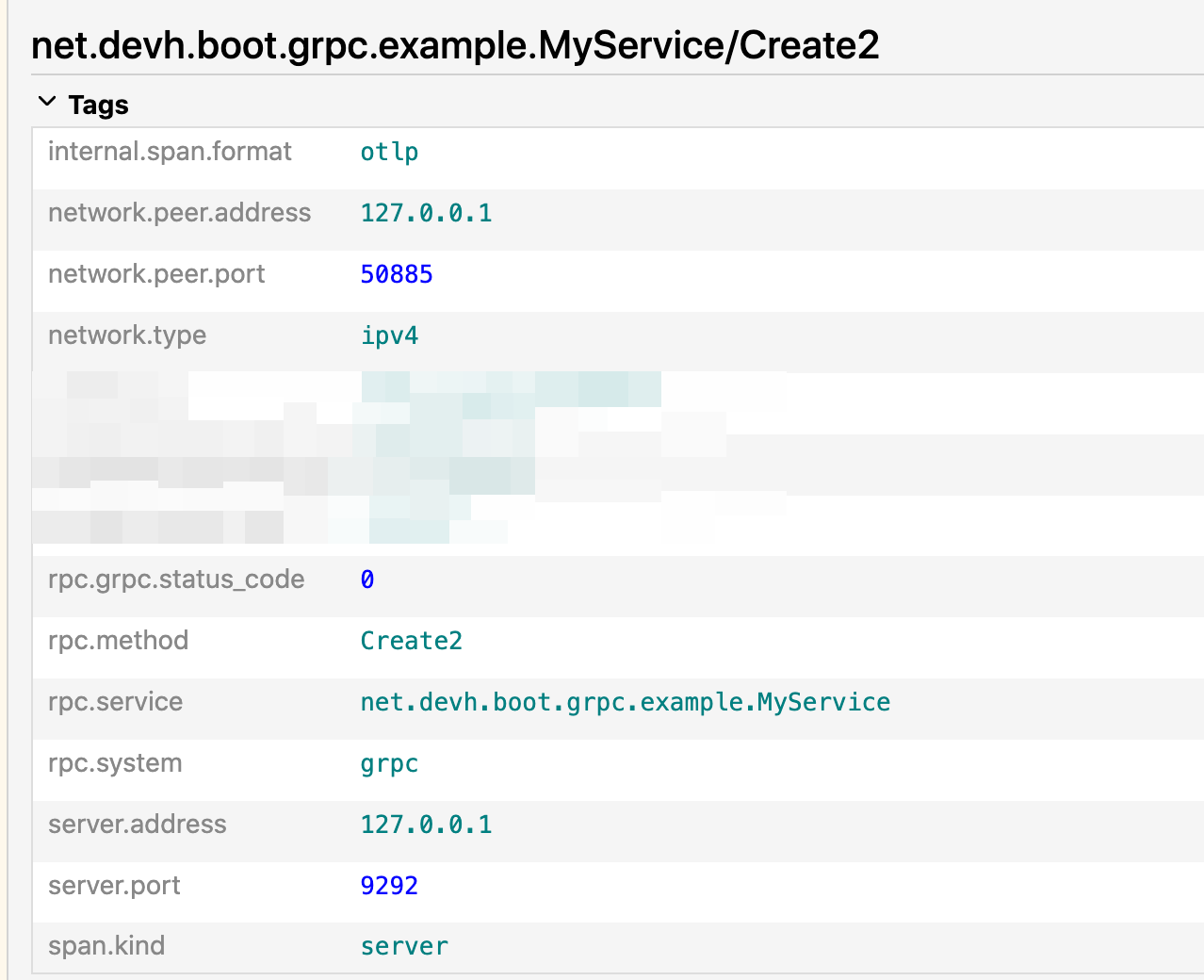
这些都是当前一些当前 span 内置的信息,比如当前 gRPC 接口的一些基本数据:服务名、ip、端口等信息。
但这里并没有上游的一些信息,虽然我们可以通过 Jaeger 的树状图得知上游是哪个应用调用过来的,但是一旦某个 span 下有多个子 span 的调用,就没办法很直观知道这个子 span 的上游是由谁发起的调用。
比如如下这个链路:

当一个调用链非常长,同时也非常复杂时,没办法第一时间知道某一个 span 的上游到底是谁发起的,需要手动一层层的去折叠,或者全靠眼睛去找。
预期效果
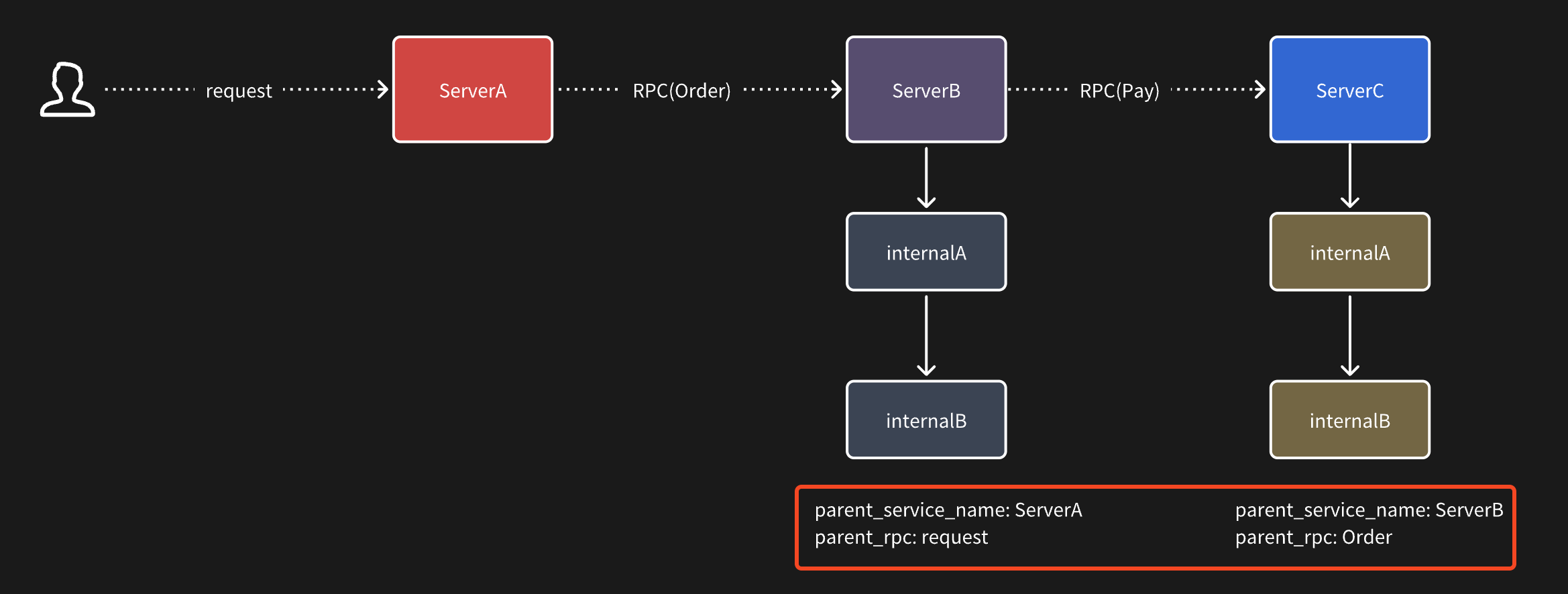
为此我们希望的效果是可以通过给每一个子 span 中加入两个 attribute,来标明它的父调用来源。
比如在 serviceB 中的所有 span 中都会加上两个标签:来源是 serviceA,同时是 serviceA 的 request 接口发起的请求。
而在 serviceC 中同样可以知道来源是 serviceB 的 Order 接口发起的调用。
我启动了三个 demo 应用,分别是 create1,create2,create3.
create1 中会提供一个 request 接口,在这里面调用 create2 的 create2 接口,create2 的接口里接着调用 create3 的 create3 接口。
create1:
@RequestMapping("/request")
public String request(@RequestParam String name) {
HelloRequest request = HelloRequest.newBuilder()
.setName(name)
.build();
log.info("request: {}", request);
String message = myServiceStub.create2(request).getMessage();
Executors.newFixedThreadPool(1).execute(() -> {
myServiceStub.create2(request).getMessage();
}); return message;
}
create2:
@Override
public void create2(HelloRequest request, StreamObserver<HelloReply> responseObserver) {
HelloReply reply = HelloReply.newBuilder()
.setMessage("Create2 ==> " + request.getName())
.build();
log.info("Create2: {}", reply.getMessage());
myMethod(request.getName());
myServiceStub.create3(request);
responseObserver.onNext(reply);
responseObserver.onCompleted();
}
create3:
@Override
public void create3(HelloRequest request, StreamObserver<HelloReply> responseObserver) {
HelloReply reply = HelloReply.newBuilder()
.setMessage("Create3 ==> " + request.getName())
.build();
log.info("Create3: {}", reply.getMessage());
myMethod(request.getName());
responseObserver.onNext(reply);
responseObserver.onCompleted();
}
java -javaagent:opentelemetry-javaagent-2.4.0-SNAPSHOT.jar \
-Dotel.javaagent.extensions=otel-extensions-custom-context-1.0-SNAPSHOT.jar \
-Dotel.traces.exporter=otlp \
-Dotel.logs.exporter=none \
-Dotel.service.name=create2 \
-Dotel.exporter.otlp.protocol=grpc \
-Dotel.propagators=tracecontext,baggage,demo \
-Dotel.exporter.otlp.endpoint=http://127.0.0.1:5317 \
-jar target/demo-0.0.1-SNAPSHOT.jar --spring.application.name=create2 --server.port=9191 --grpc.server.port=9292 --grpc.client.myService.address=static://127.0.0.1:9393
只是每个应用都需要使用我这边单独打的 agent 包以及一个 extension(tel-extensions-custom-context-1.0-SNAPSHOT.jar) 才能生效。
最终的效果如下:

Baggage
在讲具体的实现之前需要先了解几个 Trace 中的概念,在这里主要用到的是一个称为 Baggage 的对象。
在之前的文章中其实提到过它的原理以及使用场景:
从 Dapper 到 OpenTelemetry:分布式追踪的演进之旅

Baggage 的中文翻译是:包裹📦;简单来说就是我们可以通过自定义 baggage 可以将我们想要的数据存放在其中,这样再整个 Trace 的任意一个 Span 中都可以读取到。
@RequestMapping("/request")
public String request(@RequestParam String name) {
// 写入
Baggage.current().toBuilder().
put("request.name", name).build()
.storeInContext(Context.current()).makeCurrent();
}
// 获取
String value = Baggage.current().getEntryValue("request.name");
log.info("request.name: {}", value);
理解了这个之后,我们要实现的将上游的信息传递到下游就可以通过这个组件实现了。
只需要在上游创建 span 时将它自身数据写入到 Baggage 中,再到下游 span 取出来写入到 attribute 中即可。
ContextCustomizer
这里的关键就是在哪里写入这个 Baggage,因为对第三方组件的 Instrumentation 的实现都是在 opentelemetry-java-instrumentation项目中。
javaagent.jar 包也是通过该项目打包出来的。
所以在该项目的 io.opentelemetry.instrumentation.api.instrumenter.Instrumenter#doStart 这个函数中我们发现一段逻辑:

这个函数是在创建一个 span 的时候调用的,通常这个创建函数是在这些第三方库的拦截器中创建的。

比如这是在 grpc 的拦截器中调用。
// context customizers run before span start, so that they can have access to the parent span
// context, and so that their additions to the context will be visible to span processors
for (ContextCustomizer<? super REQUEST> contextCustomizer : contextCustomizers) {
context = contextCustomizer.onStart(context, request, attributes);
}
ContextCustomizer 是一个接口只提供了一个函数:
public interface ContextCustomizer<REQUEST> {
/** Allows to customize the operation {@link Context}. */
Context onStart(Context parentContext, REQUEST request, Attributes startAttributes);
}
Context是上下文信息,可以在自定义的 ContextCustomizer 继续往上下文中追加信息。REQUEST是一个泛型:一般是当前第三方组件的请求信息:- 比如是
HTTP时,这个request就是 HTTP 的请求信息。 - 而如果是
gRPC,则是gRPC的请求信息。 - 其他的请求类型同理。
- 比如是
startAttributes则是预先写入的一些属性,比如在上图中看到的一些rpc.service/rpc.method等字段。
// context customizers run before span start, so that they can have access to the parent span
// context, and so that their additions to the context will be visible to span processors
从这个接口的调用注释可以看出:
这个自定义的 context 会在 span 开始之前调用,所以在这里是可以访问到当前创建的 span 的父 context,同时在这里的 context 中新增的数据可以在 SpanProcessor 访问到。
SpanProcessor
而 SpanProcessor 又是一个非常的重要的组件,我们接着刚才的 contextCustomizer 处往后跟踪代码。
context = contextCustomizer.onStart(context, request, attributes);
--->Span span = spanBuilder.setParent(context).startSpan();
--->io.opentelemetry.sdk.trace.SdkSpanBuilder#startSpan
--->io.opentelemetry.sdk.trace.SdkSpan#startSpan
--->spanProcessor.onStart(parentContext, span);
可以看到 spanProcessor.onStart 这个函数会在 contextCustomizer 之后调用。
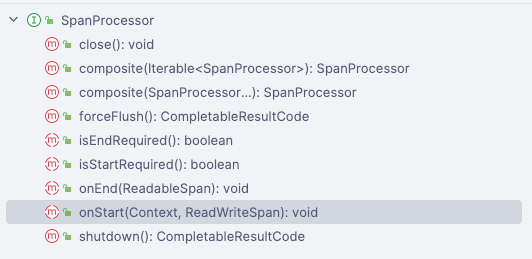
/**
* SpanProcessor is the interface {@link SdkTracer} uses to allow synchronous hooks for when a
* {@code Span} is started or when a {@code Span} is ended.
*/
//==========================================================
/**
* Called when a {@link io.opentelemetry.api.trace.Span} is started, if the {@link
* Span#isRecording()} returns true.
* * <p>This method is called synchronously on the execution thread, should not throw or block the
* execution thread. * * @param parentContext the parent {@code Context} of the span that just started.
* @param span the {@code Span} that just started.
*/void onStart(Context parentContext, ReadWriteSpan span);
从注释中可以知道 SpanProcessor 是作为一个 span 的生命周期中的关键节点的 hook 函数。
在这些函数中我们可以自定义一些 span 的数据,比如在 onStart 还可以往 span 中写入一些自定义的 attribute。
这也是我们这次会用到的一个接口,我们的方案是:
在 gRPC 构建 Instrument 时自定义一个 GrpcServerContextCustomizer ,在这个自定义的 ContextCustomizer 中写入一个 Baggage。
然后在 io.opentelemetry.sdk.trace.SpanProcessor#onStart 接口中取出这个 Baggage 写入到当前 span 的 attribute 中。
这样我们就可以看到之前提到的那些数据上游信息了。

为 gRPC 添加上下文
先来看看如何为 gRPC 添加 Baggage:
我们先自定义一个 GrpcServerContextCustomizer 实现类:
public class GrpcServerContextCustomizer implements ContextCustomizer<GrpcRequest> {
private final String currentServiceName;
private static final String PARENT_RPC_KEY = "parent_rpc";
private static final String CURRENT_RPC_KEY = "current_rpc";
private static final String CURRENT_HTTP_URL_PATH = "current_http_url_path";
public GrpcServerContextCustomizer(String serviceName) {
this.currentServiceName = serviceName;
}
@Override
public Context onStart(Context parentContext, GrpcRequest grpcRequest,
Attributes startAttributeds) {
BaggageBuilder builder = Baggage.fromContext(parentContext).toBuilder();
String currentRpc = Baggage.fromContext(parentContext).getEntryValue(CURRENT_RPC_KEY);
String fullMethodName = startAttributeds.get(AttributeKey.stringKey("rpc.method"));
String rpcService = startAttributeds.get(AttributeKey.stringKey("rpc.service"));
// call from grpc
String method = rpcService + ":" + fullMethodName;
String baggageInfo = getBaggageInfo(currentServiceName, method);
String httpUrlPath = Baggage.fromContext(parentContext).getEntryValue(CURRENT_HTTP_URL_PATH);
if (!StringUtils.isNullOrEmpty(httpUrlPath)) {
// call from http
// currentRpc = currentRpc; currentRpc = create1|GET:/request // clear current_http_url_path builder.put(CURRENT_HTTP_URL_PATH, "");
}
Baggage baggage = builder
.put(PARENT_RPC_KEY, currentRpc)
.put(CURRENT_RPC_KEY, baggageInfo)
.build();
return parentContext.with(baggage);
}
private static String getBaggageInfo(String serviceName, String method) {
if (StringUtils.isNullOrEmpty(serviceName)) {
return "";
} return serviceName + "|" + method;
}
}
从这个代码中可以看出,我们需要先从上下文中获取 CURRENT_RPC_KEY ,从而得知当前的 span 是不是 root span。
所以我们其实是把当前的 span 信息作为一个 PARENT_RPC_KEY 写入到 Baggage 中。
这样在 SpanProcessor 中便可以直接取出 PARENT_RPC_KEY 作为上游的信息写入 span 的 attribute 中。
@Override
public void onStart(Context parentContext, ReadWriteSpan span) {
String parentRpc = Baggage.fromContext(parentContext).getEntryValue("parent_rpc");
if (!StringUtils.isNullOrEmpty(parentRpc)) {
String[] split = parentRpc.split("\\|");
span.setAttribute("parent_rpc", parentRpc);
span.setAttribute("parent_service_name", split[0]);
span.setAttribute("parent_service_method", split[1]);
}
}
需要注意的是,这里的 Baggage 需要使用
Baggage.fromContext(parentContext)才能拿到刚才写入 Baggage 信息。
之后我们找到构建 gRPCServerInstrumenterBuilder 的地方,写入我们刚才自定义的 GrpcServerContextCustomizer 即可。

.addContextCustomizer(new GrpcServerContextCustomizer(serviceName))
这里我们选择写入到是 serverInstrumenterBuilder 而不是clientInstrumenterBuilder,因为在服务端的入口就知道是从哪个接口进来的请求。
为 spring boot 的 http 接口添加上下文
如果只存在 gRPC 调用时只添加 gRPC 的上下文也够用了,但是我们也不排除由外部接口是通过 HTTP 访问进来的,然后再调用内部的 gRPC 接口;这也是非常常见的架构模式。
所以我们还需要在 HTTP 中增加 ContextCustomizer 将自身的数据写入到 Baggage 中。
好在 HttpServerRouteBuilder 自身是实现了 ContextCustomizer 接口的,我们只需要往里面写入 Baggage 数据即可。
public ContextCustomizer<REQUEST> build() {
Set<String> knownMethods = new HashSet<>(this.knownMethods);
return (context, request, startAttributes) -> {
if (HttpRouteState.fromContextOrNull(context) != null) {
return context;
} String method = getter.getHttpRequestMethod(request);
if (method == null || !knownMethods.contains(method)) {
method = "HTTP";
} String urlPath = getter.getUrlPath(request);
String methodPath = method + ":" + urlPath;
String currentRpc = Baggage.fromContext(context).getEntryValue(CURRENT_RPC_KEY);
String baggageInfo = getBaggageInfo(serviceName, methodPath);
Baggage baggage = Baggage.fromContext(context).toBuilder()
.put(PARENT_RPC_KEY, currentRpc)
.put(CURRENT_RPC_KEY, baggageInfo)
.put(CURRENT_HTTP_URL_PATH, methodPath)
.build();
return context.with(HttpRouteState.create(method, null, 0))
.with(baggage);
};}
这里新增了 CURRENT_HTTP_URL_PATH 用于标记当前的请求来源是 HTTP,在 grpc 的 ContextCustomizer 解析时会判断这个值是否为空。
String httpUrlPath = Baggage.fromContext(parentContext).getEntryValue(CURRENT_HTTP_URL_PATH);
if (!StringUtils.isNullOrEmpty(httpUrlPath)) {
// call from http
// currentRpc = currentRpc; currentRpc = create1|GET:/request // clear current_http_url_path builder.put(CURRENT_HTTP_URL_PATH, "");
}

这样就可以在 grpc 的下游接口拿到入口的 HTTP 接口数据了。
当然也有可能是在 grpc 接口中调用 HTTP 的接口的场景,只是我们的业务中没有这种情况,所以就没有适配这类的场景。
总结
ContextCustomizer 接口没有提供对应的扩展,但是 SpanProcessor 是提供了扩展接口的。
原本是想尽量别维护自己的 javaagent,但也好在 OpenTelemetry 是提供的接口,所以也并不会去修改原本的代码。
所以我们还是需要创建一个 extensions 的项目在实现 SpanProcessor,这个在之前的 《实战:如何编写一个 OpenTelemetry Extensions》有详细讲到。
所以最后的应用启动方式如下:
java -javaagent:opentelemetry-javaagent-2.4.0-SNAPSHOT.jar \
-Dotel.javaagent.extensions=otel-extensions-custom-context-1.0-SNAPSHOT.jar \
需要使用我们手动打包的 javaagent 以及一个自定义扩展包。
打包方式:
./gradlew assemble
opentelemetry-java-instrumentation项目比较大,所以打包过程可能比较久。
因为这其实是一些定制需求,所以就没提交到上游,感兴趣的可以自行合并代码测试。
最后可以这个分支中查看到修改的部分:
https://github.com/crossoverJie/opentelemetry-java-instrumentation/compare/main...add-grpc-context
作者: crossoverJie

欢迎关注博主公众号与我交流。
本文版权归作者所有,欢迎转载,但未经作者同意必须保留此段声明,且在文章页面明显位置给出, 如有问题, 可邮件(crossoverJie#gmail.com)咨询。







【推荐】国内首个AI IDE,深度理解中文开发场景,立即下载体验Trae
【推荐】编程新体验,更懂你的AI,立即体验豆包MarsCode编程助手
【推荐】抖音旗下AI助手豆包,你的智能百科全书,全免费不限次数
【推荐】轻量又高性能的 SSH 工具 IShell:AI 加持,快人一步
· DeepSeek 开源周回顾「GitHub 热点速览」
· 物流快递公司核心技术能力-地址解析分单基础技术分享
· .NET 10首个预览版发布:重大改进与新特性概览!
· AI与.NET技术实操系列(二):开始使用ML.NET
· 单线程的Redis速度为什么快?